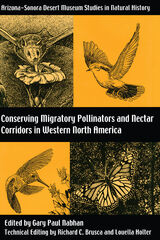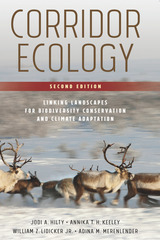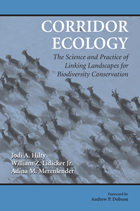3 books about Corridors (Ecology)

Conserving Migratory Pollinators and Nectar Corridors in Western North America
Gary Paul Nabhan
University of Arizona Press, 2004
When migrating birds and other creatures move along a path of plant communities in bloom, they follow what has come to be known as a nectar trail. Should any of these plants be eliminated from the sequence—whether through habitat destruction, pests, or even aberrant weather—the movement of these pollinators may be interrupted and their very survival threatened. In recent efforts by ecologists and activists to envision a continental-scale network of protected areas connected by wildlife corridors, the peculiar roles of migratory pollinators which travel the entire length of this network cannot be underestimated in shaping the ultimate conservation design.
This book, a unique work of comparative zoogeography and conservation biology, is the first to bring together studies of these important migratory pollinators and of what we must do to conserve them. It considers the similarities and differences among the behavior and habitat requirements of several species of migratory pollinators and seed dispersers in the West—primarily rufous hummingbirds, white-winged doves, lesser long-nosed bats, and monarch butterflies. It examines the population dynamics of these four species in flyways that extend from the Pacific Ocean to the continental backbone of the Sierra Madre Oriental and Rocky Mountains, and it investigates their foraging and roosting behaviors as they journey from the Tropic of Cancer in western Mexico into the deserts, grasslands, and thornscrub of the U.S.-Mexico borderlands. The four pollinators whose journeys are traced here differ dramatically from one another in foraging strategies and stopover fidelities, but all challenge many of the truisms that have emerged regarding the status of migratory species in general. The rufous hummingbird makes the longest known avian migration in relation to body size and is a key to identifying nectar corridors running through northwestern Mexico to the United States. And there is new evidence to challenge the long-supposed separation of eastern and western monarch butterfly populations by the Rocky Mountains as these insects migrate.
Conserving Migratory Pollinators and Nectar Corridors in Western North America demonstrates new efforts to understand migratory species and to determine whether their densities, survival rates, and health are changing in response to changes in the distribution and abundance of nectar plants found within their ranges. Representing collaborative efforts that bridge field ecology and conservation biology in both theory and practice, it is dedicated to safeguarding dynamic interactions among plants and pollinators that are only now being identified.
This book, a unique work of comparative zoogeography and conservation biology, is the first to bring together studies of these important migratory pollinators and of what we must do to conserve them. It considers the similarities and differences among the behavior and habitat requirements of several species of migratory pollinators and seed dispersers in the West—primarily rufous hummingbirds, white-winged doves, lesser long-nosed bats, and monarch butterflies. It examines the population dynamics of these four species in flyways that extend from the Pacific Ocean to the continental backbone of the Sierra Madre Oriental and Rocky Mountains, and it investigates their foraging and roosting behaviors as they journey from the Tropic of Cancer in western Mexico into the deserts, grasslands, and thornscrub of the U.S.-Mexico borderlands. The four pollinators whose journeys are traced here differ dramatically from one another in foraging strategies and stopover fidelities, but all challenge many of the truisms that have emerged regarding the status of migratory species in general. The rufous hummingbird makes the longest known avian migration in relation to body size and is a key to identifying nectar corridors running through northwestern Mexico to the United States. And there is new evidence to challenge the long-supposed separation of eastern and western monarch butterfly populations by the Rocky Mountains as these insects migrate.
Conserving Migratory Pollinators and Nectar Corridors in Western North America demonstrates new efforts to understand migratory species and to determine whether their densities, survival rates, and health are changing in response to changes in the distribution and abundance of nectar plants found within their ranges. Representing collaborative efforts that bridge field ecology and conservation biology in both theory and practice, it is dedicated to safeguarding dynamic interactions among plants and pollinators that are only now being identified.
[more]

Corridor Ecology, Second Edition
Linking Landscapes for Biodiversity Conservation and Climate Adaptation
Jodi A. Hilty, Annika T. H. Keeley, William Z. Lidicker Jr., Adina M. Merenlender
Island Press, 2019
Migrating wildlife species across the globe face a dire predicament as their traditional migratory routes are cut off by human encroachment. Forced into smaller and smaller patches of habitat, they must compete more aggressively for dwindling food resources and territory. This is more than just an unfortunate side effect of human progress. As key species populations dwindle, ecosystems are losing resilience and face collapse, and along with them, the ecosystem services we depend on. Healthy ecosystems need healthy wildlife populations. One possible answer? Wildlife corridors that connect fragmented landscapes.
This new and expanded second edition of Corridor Ecology: Linking Landscapes for Biodiversity Conservation and Climate Adaptation captures the many advances in the field over the past ten years. It builds on concepts presented in the first edition on the importance and practical details of maintaining and restoring land connectivity. New to this edition is a guest-edited chapter on ecological connectivity in oceans, including a detailed discussion on pelagic marine corridors and how coastal corridors can provide critical connectivity between marine protected areas. Another new chapter considers the effects of climate change on habitat and offers recommendations on designing effective corridors as landscapes change with shifting climate conditions. The book also includes a discussion of corridors in the air for migrating flying species, from birds to bats, butterflies, and even plant propagules—a concept so new that a term to describe it has yet to be coined. All chapters are thoroughly revised and updated.
Practitioners as well as serious scholars of landscape ecology and the science of protecting biodiversity will find this new edition of corridor ecology science an indispensable resource.
This new and expanded second edition of Corridor Ecology: Linking Landscapes for Biodiversity Conservation and Climate Adaptation captures the many advances in the field over the past ten years. It builds on concepts presented in the first edition on the importance and practical details of maintaining and restoring land connectivity. New to this edition is a guest-edited chapter on ecological connectivity in oceans, including a detailed discussion on pelagic marine corridors and how coastal corridors can provide critical connectivity between marine protected areas. Another new chapter considers the effects of climate change on habitat and offers recommendations on designing effective corridors as landscapes change with shifting climate conditions. The book also includes a discussion of corridors in the air for migrating flying species, from birds to bats, butterflies, and even plant propagules—a concept so new that a term to describe it has yet to be coined. All chapters are thoroughly revised and updated.
Practitioners as well as serious scholars of landscape ecology and the science of protecting biodiversity will find this new edition of corridor ecology science an indispensable resource.
[more]

Corridor Ecology
The Science and Practice of Linking Landscapes for Biodiversity Conservation
Jodi A. Hilty, William Z. Lidicker Jr., and Adina M. Merenlender; Foreword by Andrew P. Dobson
Island Press, 2006
Corridor Ecology presents guidelines that combine conservation science and practical experience for maintaining, enhancing, and creating connectivity between natural areas with an overarching goal of conserving biodiversity. It offers an objective, carefully interpreted review of the issues and is a one-of-a-kind resource for scientists, landscape architects, planners, land managers, decision-makers, and all those working to protect and restore landscapes and species diversity.
[more]
READERS
Browse our collection.
PUBLISHERS
See BiblioVault's publisher services.
STUDENT SERVICES
Files for college accessibility offices.
UChicago Accessibility Resources
home | accessibility | search | about | contact us
BiblioVault ® 2001 - 2024
The University of Chicago Press









